


Its popularity within the commercial world of galleries reached great heights during the mid-1980s, as Neo-expressionist paintings became the hottest buying and selling item out there. The movement had an immense influence on the art market in Europe and the US during its relatively short period of existence. With a base in New York City, American creatives like Julian Schnabel, David Salle, Eric Fischl and even Jean-Michel Basquiat challenged the content that was shown within galleries, bringing in personal, sensitive works of art. Across the ocean, however, the United States warmly welcomed the return of the expression in the early 1980s. With a strong sense of parody, their style was fairly similar to the German one, something that could be seen in the works of Sandro Chia, Francesco Clemente and Enzo Cucchi. Further south on the European continent, Italy introduced its own version of the trend, called Trans-Avantgarde, introduced by critic Achille Bonito Oliva as a response to another Italian influential avant-guard, Arte Povera. The group created works inspired by Munch, de Kooning and even late Picasso, dealing with their country’s troubled post-war history and Nazi legacy. Penck, Eugen Schonebeck and Markus Lupertz. In the following decade, Baselitz became the most prominent figure of Neo-expressionist figurative painting in Germany, in company of artists like Anselm Kiefer, A.R.


His show was dismantled shortly after it was set up, due to “indecency” - some of the paintings depicted masturbations, while others showed male figures with an erection. The first signs of Neo-expressionism were pin-pointed to the year 1963, when Georg Baselitz opened a shocking exhibition in West Berlin. Such approach was well-received in the early and mid-1980s, and many classify it as a trend, rather than a proper movement. The artists practically declared war on narration and embraced iconography, primitivism, nature, mythology and history, sometimes in a provocative manner too. It was more about the form, the way an artwork is done, rather than what’s represented through it. What characterizes the artworks of Neo-expressionism is an immediate return to painting as the primary, almost organic part of artistry - this reflects perfectly in often large-scale pieces, covered in thick layers of paint and raw brushstrokes of intense colors. Neo-expressionism - Ideas, Concepts, Style With strong sense of artistic power, neo-expressionist artists painted and drew upon a variety of topics, such as mythology, history, culture and even erotica. From its conception years through late 1980s, it spread across the world, leaving the strongest marks on Italy and the United States. Emerging in the late 1970s, it was often called Neue Wilden - the New Wild Ones, for its origins in West Germany, and it represented the return to Expressionism, sometimes in lightly abstract ways. Conceptual art was born as a reaction to Formalism, Minimalism aimed to be the exact opposite of Abstract Expressionism, and then there was Neo- expressionism, which strived to go back to objectivity in painting and sculpture, the portrayal of recognizable objects rather than just concepts, ideas and visions. When we look at the art scene of the 20th century, we see that some of the greatest avant-garde movements came to life as a result of a complete revolt towards some other movement.


 0 kommentar(er)
0 kommentar(er)
